Top 8 Deadliest Cats
Cats are some of the most effective predators in the world. The fact that so many unique species spread across the earth is the result of over a dozen migrations across the Bering Strait stretching over millions of years is a demonstration that their basic anatomy can translate well into a wide variety of environments. Fossil records analyzed in 2015 even suggest that the effectiveness of feline species to become apex predators in their environment may have stifled the growth and differentiation of contemporary canines.
That said, what qualifies as success for predators in the wild might surprise you. Most mammalian predators catch less than half of the prey they pursue — and while the success rates of cat species tend to be higher, that’s not telling the whole story. Cats in the wild are typically pursuit predators, which means that even a successful hunt requires pretty sizable energy expenditure. And the fact that most species are solitary predators means that there’s no contingency plan if a hunt goes bad.
Success rates only tell us so much — particularly when taking into account the complicated conditions and changes within a given ecosystem — but they do give us a place to start from. These are the eight deadliest cats in the world ranked by their success rates as hunters.
1. Black-Footed Cat
Success Rate: 60%

slowmotiongli/Shutterstock.com
The most successful predator in the world may be the dragonfly thanks to its recorded hunting success rate of 95%, so it shouldn’t come as a complete surprise that the most dangerous cat in the wild is also one of the smallest species. Weighing barely three pounds and hailing from South Africa, the black-footed cat is the top predator for birds and mice within its savanna ecosystem. As lions stalk gazelles and wildebeests, the black-footed cat uses its exceptional night vision and hearing to hunt exclusively under the cover of darkness and takes advantage of its tiny body to slink carefully through the tall grass.
But success rates of 60% might actually be a necessity for these predators. The incredibly fast metabolism of the black-footed cat ensures that it needs to eat up to a third of its body weight to survive and that they sleep only a fraction of the time that most cat species do.
You can learn about some of the world’s other cutest animals — albeit ones significantly less deadly than the black-footed cat — here.
2. Cheetah
Success Rate: 58%
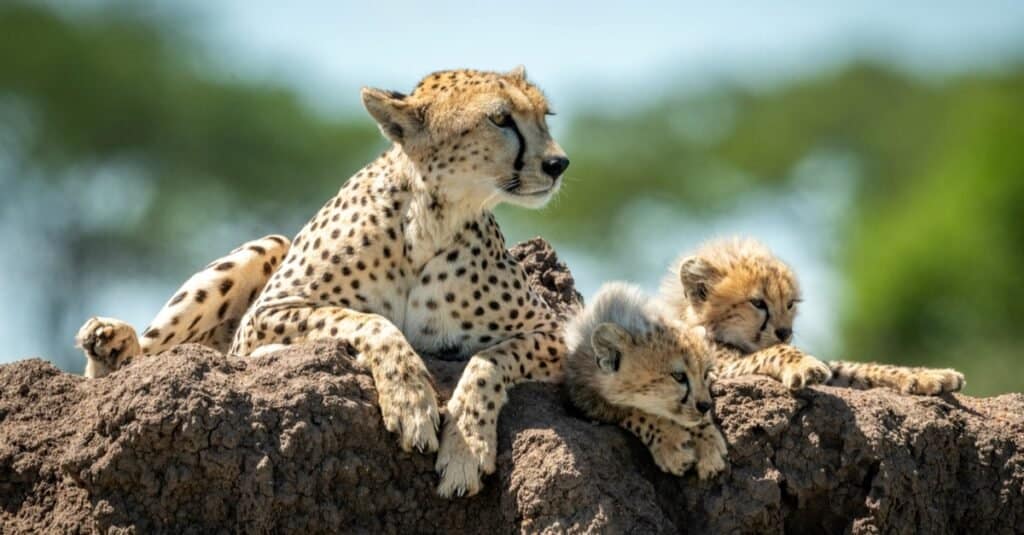
iStock.com/nicholas_dale
The black-footed cat and cheetah both have fast metabolisms, but the former has to spend roughly all of its waking time hunting, while the latter instead focuses on being as efficient with its energy usage as possible. Reaching a top speed of 80 miles per hour requires a lot of energy, but the ability to accelerate to 60 in just three seconds allows them to overcome most prey before it becomes a race of endurance and the cost of energy becomes far pricier.
Cheetahs are also known for being highly maneuverable and can shift with their prey’s movements almost seamlessly. But the threat from other big cats is a demonstration that being a successful hunter doesn’t always mean that you can keep that prey. Despite the risk of overheating in the harsh African sun, cheetahs tend to hunt during dusk, dawn, or daytime to prevent their kill from being poached or stolen by other predators.
Cheetahs can regularly go up to five days without feeding, and you can learn more interesting facts about these deadliest cats here.
3. Leopard
Success Rate: 38%
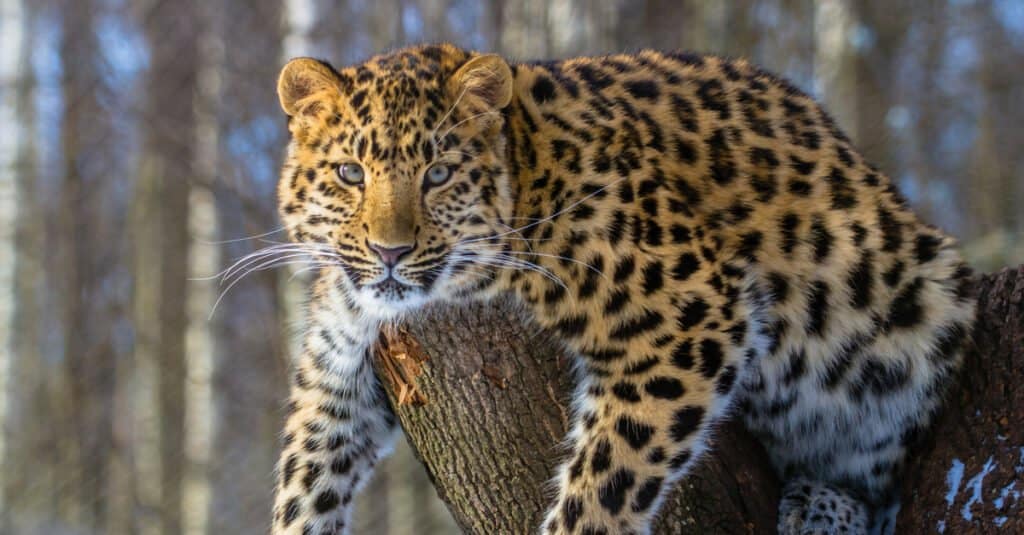
Dmitri Gomon/Shutterstock.com
Leopards take a different approach to avoiding territorial aggression or poaching from hyenas, lions, and other big cats. They simply bring their meals into the trees where they can eat unmolested by more terrestrial threats. Though they aren’t the biggest cats on the planet, these felines have powerful bodies that can drag carcasses weighing over a hundred pounds straight up a tree trunk.
Leopards are opportunistic hunters who primarily chase ungulates like impala and gazelles, but they’re not above going after mice or birds or even venturing into the waters to go fishing. Their diet can range from monkeys to warthogs to porcupines, and they aren’t above even snacking on cheetah cubs when the opportunity strikes. Though they’re fast enough to reach speeds of nearly 40 miles per hour, these deadliest cats prefer to use their camouflaged fur to sneak close to their prey and then kill them with a single bite of their powerful jaws.
You can learn more about the unique ambush predator known as the leopard here.
4. Domesticated Cat
Success Rate: 32%
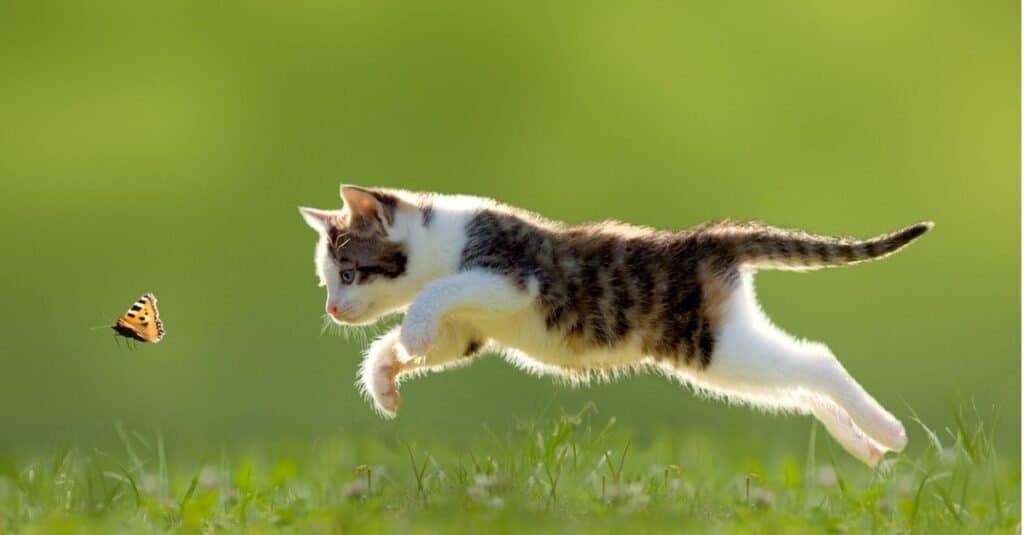
iStock.com/Leoba
While it can be easy to think of dogs and cats have become “civilized” over the course of domestication, it’s important to remember that cats domesticated themselves by being so effective at hunting for rats and other pests in and near human settlements. Their popularity as pets has grown all over the world, but that prodigious spread has also allowed them to become one of the world’s deadliest non-native invasive species.
Though they occupy very small territories — often consisting of one or two suburban yards — feral and outdoor pet cats can utterly devastate rodent and bird communities within those bubbles. When looking at these territories in aggregate, domesticated cats have the potential to change a biome dramatically even if they only kill roughly one in three animals they hunt.
Some domesticated cat breeds are more dangerous than others, but you can figure out the details here.
5. Lion
Success Rate: 25%
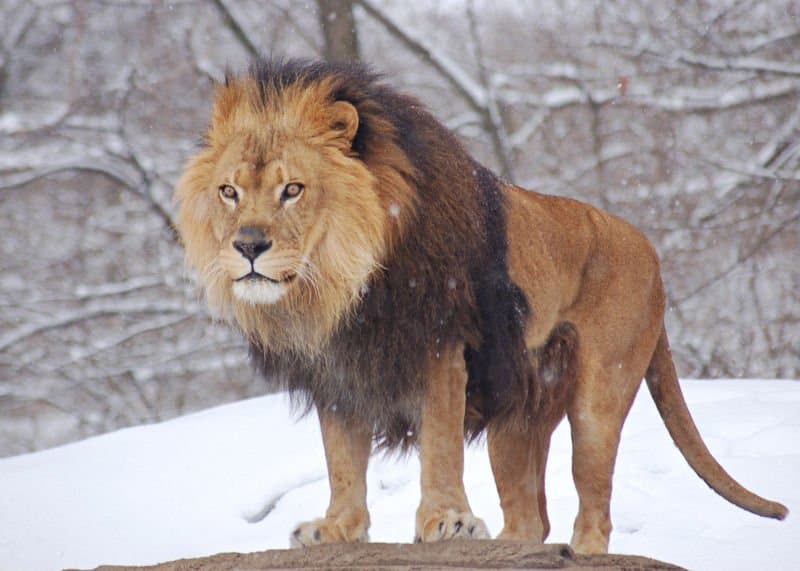
It’s no coincidence that lions enjoy a low overall success rate as hunters while also employing group tactics to bring down prey. Wolf packs are only successful in roughly one out of ten hunts, but there’s strength in numbers, and the cost of splitting a meal doesn’t matter nearly so much when that meal is a fat caribou.
Lions engage in similar tactics, using ambush techniques to get as close to a herd of prey animals as possible and then working together to take down the weakest and most vulnerable members of the fleeing herd. Without the speed of the cheetah or the stealth of the jaguar, lions have developed different hunting techniques. Yet despite not being the most successful hunter in the cat family lions still fear little other than packs of hyenas — making it clear that hunting rates aren’t necessarily a perfect statistic for identifying the most dangerous cat species.
Learn more about the unique social dynamics of these big cats here.
6. Puma
Success Rate: 20%

iStock.com/Kara Capaldo
If you want a more direct comparison between the success rates of felines and canines, look no further than the relationship between pumas and wolves. As ambush predators that get as close as possible to their prey before striking, pumas enjoy both a higher success rate and a higher overall volume of kills than wolves. That comes down to hunting strategies, with pumas being more patient ambush predators and wolves working together to harry and wear down prey. But being a successful hunter doesn’t mean representing the top of the social hierarchy in an environment. Because while wolves may have comparatively dismal success rates at hunting, they actively kill puma cubs and freeze adult mountain lions out of hunting grounds when the territory between these two predators overlap.
You can learn more about the puma, which is also known as the cougar or mountain lion, here.
7. Tiger
Success Rate: 5 – 10%

dangdumrong/Shutterstock.com
The success rate of tigers is a good reminder of what an important factor prey availability is. While a tiger’s success rates in the wild will normally hover between 10 and 20 percent, they’re still the apex predators in their ecosystems. Smaller predators like dholes and leopards typically find themselves having to defer to the local tiger populations, and tigers are prone to maintaining large territories so that prey sources are always available. That’s the privilege of being the biggest and most dangerous animal within the biome.
It helps that tigers only need to eat about once a week and rarely have to worry about other predators stealing with meals. But in environments like Russia — where larger game and snowy environments prevail — tigers may exhibit success rates approaching or even surpassing half when hunting boar or red deer. In either case, a tiger is almost always the most dangerous cat in its habitat.
You can discover more about this fierce and solitary predator, one of the deadliest cats, here.
8. Bobcat
Success Rate: Unknown
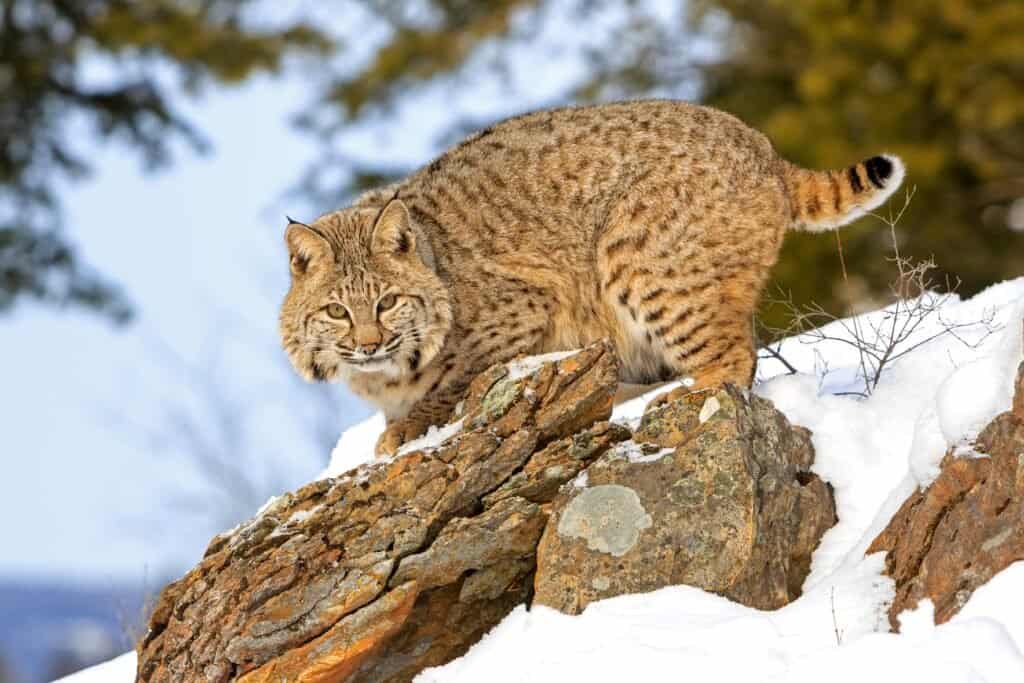
Jack Bell Photography/Shutterstock.com
They might not be the biggest cat in the world, but the roughly 40-pound bobcat is definitely enough to pose a threat to both humans and their pets — and their success as predators has allowed them to become the most populous wildcat in North America.
As generalist predators that are capable of hunting large ungulates but don’t need them to survive, bobcats can subsist on everything from mice and small birds to deer. That’s allowed them to pose a danger to practically any prey animals in their environment, but it’s ultimately a win for the natural balance. In a manner similar to coyotes, the highly adaptable bobcat can slot nicely into an existing habitat and provide balanced population control in areas lacking predator species, making them one of the deadliest cats out there.
There are roughly 3 million bobcats in the United States, and you can discover more about them here.
According to our research, the 8 deadliest cats are:
Next Up: Dog Paws: Everything You Wanted to Know About Your Dog’s Foot
More from A-Z Animals
Cats are some of the most effective predators in the world. The fact that so many unique species spread across the earth is the result of over a dozen migrations across the Bering Strait stretching over millions of years is a demonstration that their basic anatomy can translate well into a wide variety of environments. Fossil records analyzed in 2015 even suggest that the effectiveness of feline species to become apex predators in their environment may have stifled the growth and differentiation of contemporary canines.
That said, what qualifies as success for predators in the wild might surprise you. Most mammalian predators catch less than half of the prey they pursue — and while the success rates of cat species tend to be higher, that’s not telling the whole story. Cats in the wild are typically pursuit predators, which means that even a successful hunt requires pretty sizable energy expenditure. And the fact that most species are solitary predators means that there’s no contingency plan if a hunt goes bad.
Success rates only tell us so much — particularly when taking into account the complicated conditions and changes within a given ecosystem — but they do give us a place to start from. These are the eight deadliest cats in the world ranked by their success rates as hunters.
1. Black-Footed Cat
Success Rate: 60%

slowmotiongli/Shutterstock.com
The most successful predator in the world may be the dragonfly thanks to its recorded hunting success rate of 95%, so it shouldn’t come as a complete surprise that the most dangerous cat in the wild is also one of the smallest species. Weighing barely three pounds and hailing from South Africa, the black-footed cat is the top predator for birds and mice within its savanna ecosystem. As lions stalk gazelles and wildebeests, the black-footed cat uses its exceptional night vision and hearing to hunt exclusively under the cover of darkness and takes advantage of its tiny body to slink carefully through the tall grass.
But success rates of 60% might actually be a necessity for these predators. The incredibly fast metabolism of the black-footed cat ensures that it needs to eat up to a third of its body weight to survive and that they sleep only a fraction of the time that most cat species do.
You can learn about some of the world’s other cutest animals — albeit ones significantly less deadly than the black-footed cat — here.
2. Cheetah
Success Rate: 58%

iStock.com/nicholas_dale
The black-footed cat and cheetah both have fast metabolisms, but the former has to spend roughly all of its waking time hunting, while the latter instead focuses on being as efficient with its energy usage as possible. Reaching a top speed of 80 miles per hour requires a lot of energy, but the ability to accelerate to 60 in just three seconds allows them to overcome most prey before it becomes a race of endurance and the cost of energy becomes far pricier.
Cheetahs are also known for being highly maneuverable and can shift with their prey’s movements almost seamlessly. But the threat from other big cats is a demonstration that being a successful hunter doesn’t always mean that you can keep that prey. Despite the risk of overheating in the harsh African sun, cheetahs tend to hunt during dusk, dawn, or daytime to prevent their kill from being poached or stolen by other predators.
Cheetahs can regularly go up to five days without feeding, and you can learn more interesting facts about these deadliest cats here.
3. Leopard
Success Rate: 38%

Dmitri Gomon/Shutterstock.com
Leopards take a different approach to avoiding territorial aggression or poaching from hyenas, lions, and other big cats. They simply bring their meals into the trees where they can eat unmolested by more terrestrial threats. Though they aren’t the biggest cats on the planet, these felines have powerful bodies that can drag carcasses weighing over a hundred pounds straight up a tree trunk.
Leopards are opportunistic hunters who primarily chase ungulates like impala and gazelles, but they’re not above going after mice or birds or even venturing into the waters to go fishing. Their diet can range from monkeys to warthogs to porcupines, and they aren’t above even snacking on cheetah cubs when the opportunity strikes. Though they’re fast enough to reach speeds of nearly 40 miles per hour, these deadliest cats prefer to use their camouflaged fur to sneak close to their prey and then kill them with a single bite of their powerful jaws.
You can learn more about the unique ambush predator known as the leopard here.
4. Domesticated Cat
Success Rate: 32%

iStock.com/Leoba
While it can be easy to think of dogs and cats have become “civilized” over the course of domestication, it’s important to remember that cats domesticated themselves by being so effective at hunting for rats and other pests in and near human settlements. Their popularity as pets has grown all over the world, but that prodigious spread has also allowed them to become one of the world’s deadliest non-native invasive species.
Though they occupy very small territories — often consisting of one or two suburban yards — feral and outdoor pet cats can utterly devastate rodent and bird communities within those bubbles. When looking at these territories in aggregate, domesticated cats have the potential to change a biome dramatically even if they only kill roughly one in three animals they hunt.
Some domesticated cat breeds are more dangerous than others, but you can figure out the details here.
5. Lion
Success Rate: 25%

It’s no coincidence that lions enjoy a low overall success rate as hunters while also employing group tactics to bring down prey. Wolf packs are only successful in roughly one out of ten hunts, but there’s strength in numbers, and the cost of splitting a meal doesn’t matter nearly so much when that meal is a fat caribou.
Lions engage in similar tactics, using ambush techniques to get as close to a herd of prey animals as possible and then working together to take down the weakest and most vulnerable members of the fleeing herd. Without the speed of the cheetah or the stealth of the jaguar, lions have developed different hunting techniques. Yet despite not being the most successful hunter in the cat family lions still fear little other than packs of hyenas — making it clear that hunting rates aren’t necessarily a perfect statistic for identifying the most dangerous cat species.
Learn more about the unique social dynamics of these big cats here.
6. Puma
Success Rate: 20%

iStock.com/Kara Capaldo
If you want a more direct comparison between the success rates of felines and canines, look no further than the relationship between pumas and wolves. As ambush predators that get as close as possible to their prey before striking, pumas enjoy both a higher success rate and a higher overall volume of kills than wolves. That comes down to hunting strategies, with pumas being more patient ambush predators and wolves working together to harry and wear down prey. But being a successful hunter doesn’t mean representing the top of the social hierarchy in an environment. Because while wolves may have comparatively dismal success rates at hunting, they actively kill puma cubs and freeze adult mountain lions out of hunting grounds when the territory between these two predators overlap.
You can learn more about the puma, which is also known as the cougar or mountain lion, here.
7. Tiger
Success Rate: 5 – 10%

dangdumrong/Shutterstock.com
The success rate of tigers is a good reminder of what an important factor prey availability is. While a tiger’s success rates in the wild will normally hover between 10 and 20 percent, they’re still the apex predators in their ecosystems. Smaller predators like dholes and leopards typically find themselves having to defer to the local tiger populations, and tigers are prone to maintaining large territories so that prey sources are always available. That’s the privilege of being the biggest and most dangerous animal within the biome.
It helps that tigers only need to eat about once a week and rarely have to worry about other predators stealing with meals. But in environments like Russia — where larger game and snowy environments prevail — tigers may exhibit success rates approaching or even surpassing half when hunting boar or red deer. In either case, a tiger is almost always the most dangerous cat in its habitat.
You can discover more about this fierce and solitary predator, one of the deadliest cats, here.
8. Bobcat
Success Rate: Unknown

Jack Bell Photography/Shutterstock.com
They might not be the biggest cat in the world, but the roughly 40-pound bobcat is definitely enough to pose a threat to both humans and their pets — and their success as predators has allowed them to become the most populous wildcat in North America.
As generalist predators that are capable of hunting large ungulates but don’t need them to survive, bobcats can subsist on everything from mice and small birds to deer. That’s allowed them to pose a danger to practically any prey animals in their environment, but it’s ultimately a win for the natural balance. In a manner similar to coyotes, the highly adaptable bobcat can slot nicely into an existing habitat and provide balanced population control in areas lacking predator species, making them one of the deadliest cats out there.
There are roughly 3 million bobcats in the United States, and you can discover more about them here.
According to our research, the 8 deadliest cats are:
Next Up: Dog Paws: Everything You Wanted to Know About Your Dog’s Foot






